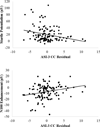Anxiety sensitivity and the anticipation of predictable and unpredictable threat: Evidence from the startle response and event-related potentials
- PMID: 26005838
- PMCID: PMC4480216
- DOI: 10.1016/j.janxdis.2015.05.003
Anxiety sensitivity and the anticipation of predictable and unpredictable threat: Evidence from the startle response and event-related potentials
Abstract
There is growing evidence that heightened sensitivity to unpredictable threat is a core mechanism of dysfunction in anxiety disorders. However, it is unclear whether anxiety sensitivity is also associated with sensitivity to unpredictable threat. In the present study, 131 participants completed the Anxiety Sensitivity Index-3, which includes physical concerns (PC), social concerns (SC), and cognitive concerns (CC) subscales, and a predictable vs. unpredictable threat-of-shock task. Startle eyeblink and ERP responses (N100, P300) to the acoustic startle probes were measured during the task. PC and CC were associated with heightened and attenuated, respectively, startle for the unpredictable (but not predictable) condition. CC were also associated with attenuated probe N100 for the unpredictable condition only, and PC were associated with increased P300 suppression across the predictable and unpredictable conditions. This study provides novel evidence that the different anxiety sensitivity dimensions demonstrate unique relationships with the RDoC domains "acute" and "potential" threat.
Keywords: Anxiety sensitivity; Event-related potentials; Predictability; Startle response.
Copyright © 2015 Elsevier Ltd. All rights reserved.
Figures




Similar articles
-
Event-related potentials to acoustic startle probes during the anticipation of predictable and unpredictable threat.Psychophysiology. 2015 Jul;52(7):887-94. doi: 10.1111/psyp.12418. Epub 2015 Feb 22. Psychophysiology. 2015. PMID: 25703182
-
The effect of panic disorder versus anxiety sensitivity on event-related potentials during anticipation of threat.J Anxiety Disord. 2018 Mar;54:1-10. doi: 10.1016/j.janxdis.2017.12.001. Epub 2017 Dec 15. J Anxiety Disord. 2018. PMID: 29291580 Free PMC article.
-
Anxiety and Depression Symptom Dimensions Demonstrate Unique Relationships with the Startle Reflex in Anticipation of Unpredictable Threat in 8 to 14 Year-Old Girls.J Abnorm Child Psychol. 2017 Feb;45(2):397-410. doi: 10.1007/s10802-016-0169-1. J Abnorm Child Psychol. 2017. PMID: 27224989 Free PMC article.
-
The impact of startle reactivity to unpredictable threat on the relation between bullying victimization and internalizing psychopathology.J Psychiatr Res. 2019 Dec;119:7-13. doi: 10.1016/j.jpsychires.2019.09.004. Epub 2019 Sep 6. J Psychiatr Res. 2019. PMID: 31520836 Free PMC article. Review.
-
Using Event-Related Potentials and Startle to Evaluate Time Course in Anxiety and Depression.Biol Psychiatry Cogn Neurosci Neuroimaging. 2018 Jan;3(1):10-18. doi: 10.1016/j.bpsc.2017.09.004. Epub 2017 Sep 20. Biol Psychiatry Cogn Neurosci Neuroimaging. 2018. PMID: 29397073 Free PMC article. Review.
Cited by
-
Don't worry, it won't be fine. Contributions of worry and anxious arousal to startle responses and event-related potentials in threat anticipation.Cogn Affect Behav Neurosci. 2023 Aug;23(4):1141-1159. doi: 10.3758/s13415-023-01094-4. Epub 2023 Apr 27. Cogn Affect Behav Neurosci. 2023. PMID: 37106311 Free PMC article.
-
Neuroimaging-based evidence for sympathetic correlation between brain activity and peripheral vasomotion during pain anticipation.Sci Rep. 2024 Feb 9;14(1):3383. doi: 10.1038/s41598-024-53921-4. Sci Rep. 2024. PMID: 38337009 Free PMC article.
-
The Impact of Unpredictability on Dyspnea Perception, Anxiety and Interoceptive Error Processing.Front Physiol. 2019 May 3;10:535. doi: 10.3389/fphys.2019.00535. eCollection 2019. Front Physiol. 2019. PMID: 31130876 Free PMC article.
-
Shared and unique neural circuitry underlying temporally unpredictable threat and reward processing.Soc Cogn Affect Neurosci. 2021 Mar 24;16(4):370-382. doi: 10.1093/scan/nsab006. Soc Cogn Affect Neurosci. 2021. PMID: 33449089 Free PMC article.
-
Posttraumatic stress symptom dimensions and brain responses to startling auditory stimuli in combat veterans.J Abnorm Psychol. 2021 Jul;130(5):455-467. doi: 10.1037/abn0000552. J Abnorm Psychol. 2021. PMID: 34472883 Free PMC article.
References
-
- Allan NP, Capron DW, Raines AM, Schmidt NB. Unique relations among anxiety sensitivity factors and anxiety, depression, and suicidal ideation. Journal of Anxiety Disorders. 2014;28:266–275. - PubMed
-
- Allan NP, Macatee RJ, Norr AM, Schmidt NB. Direct and interactive effects of distress tolerance and anxiety sensitivity on generalized anxiety and depression. Cognitive Therapy and Research. 2014;38:530–540.
-
- Allen NB, Trinder J, Brennan C. Affective startle modulation in clinical depression: Preliminary findings. Biological Psychiatry. 1999;46:542–550. - PubMed
-
- Asmundson GJG, Weeks JW, Carleton RN, Thibodeau Ma, Fetzner MG. Revisiting the latent structure of the anxiety sensitivity construct: more evidence of dimensionality. Journal of Anxiety Disorders. 2011;25:138–147. - PubMed
Publication types
MeSH terms
Grants and funding
LinkOut - more resources
Full Text Sources
Other Literature Sources
Medical
Miscellaneous

